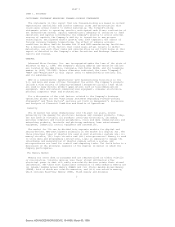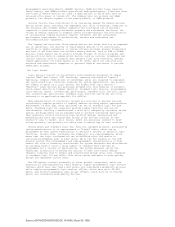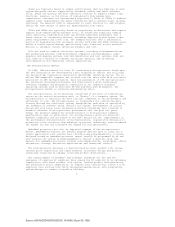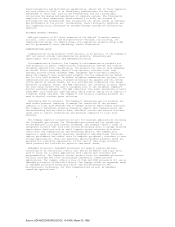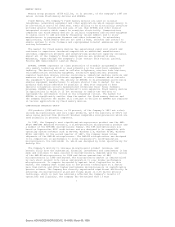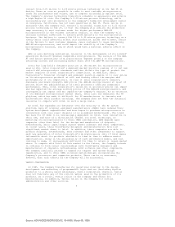AMD 1997 Annual Report Download - page 16
Download and view the complete annual report
Please find page 16 of the 1997 AMD annual report below. You can navigate through the pages in the report by either clicking on the pages listed below, or by using the keyword search tool below to find specific information within the annual report.as by the majority of other companies in the semiconductor industry, are
principally supplied by a few foreign companies. Shortages could occur in
various essential materials due to interruption of supply or increased demand
in the industry. If AMD were unable to procure certain of such materials, it
would be required to reduce its manufacturing operations which could have a
material adverse effect on the Company. To date, AMD has not experienced
significant difficulty in obtaining necessary raw materials.
ENVIRONMENTAL REGULATIONS
The failure to comply with present or future governmental regulations
related to the use, storage, handling, discharge or disposal of toxic,
volatile or otherwise hazardous chemicals used in the manufacturing process
could result in fines being imposed on the Company, suspension of production,
alteration of the Company's manufacturing processes or cessation of
operations. Such regulations could require the Company to acquire expensive
remediation equipment or to incur other expenses to comply with environmental
regulations. Any failure by the Company to control the use, disposal or
storage of, or adequately restrict the discharge of, hazardous substances
could subject the Company to future liabilities and could have a material
adverse effect on the Company.
INTELLECTUAL PROPERTY AND LICENSING
AMD and its subsidiaries have been granted over 1,400 United States patents,
and over 2,000 patent applications are pending in the United States. In
certain cases, the Company has filed corresponding applications in foreign
jurisdictions. The Company expects to file future patent applications in both
the United States and abroad on significant inventions as it deems
appropriate.
In January of 1995, the Company and Intel reached an agreement to settle all
previously outstanding legal disputes between the two companies. As part of
the settlement, in December 1995, the Company signed a five-year,
comprehensive cross-license agreement with Intel which expires on December 31,
2000. The agreement provides that after December 20, 1999, the parties will
negotiate in good faith a patent cross-license agreement to be effective
January 1, 2001. The cross-license agreement gives the Company and Intel the
right to use each others' patents and certain copyrights, including copyrights
to the x86 instruction sets but excluding other microprocessor microcode
copyrights beyond the Intel 486 processor code. The cross-license is royalty-
bearing for the Company's products that use certain Intel technologies. The
Company is required to pay Intel minimum non-refundable royalties during the
years 1997 through 2000.
In addition, AMD has entered into numerous cross-licensing and technology
exchange agreements with other companies under which it both transfers and
receives technology and intellectual property rights. Although the Company
attempts to protect its intellectual property rights through patents,
copyrights, trade secrets and other measures, there can be no assurance that
the Company will be able to protect its technology or other intellectual
property adequately or that competitors will not be able to develop similar
technology independently. There can be no assurance that any patent
applications that the Company may file will be issued or that foreign
intellectual property laws will protect the Company's intellectual property
rights. There can be no assurance that any patent licensed by or issued to the
Company will not be challenged, invalidated or circumvented, or that the
rights granted thereunder will provide competitive advantages to the Company.
Furthermore, there can be no assurance that others will not independently
develop similar products, duplicate the Company's products or design around
the Company's patents and other rights.
From time to time, AMD has been notified that it may be infringing
intellectual property rights of others. If any such claims are asserted
against the Company, the Company may seek to obtain a license under the third
party's intellectual property rights. The Company could decide, in the
alternative, to resort to litigation to challenge such claims. Such challenges
could be extremely expensive and time-consuming and could materially adversely
affect the Company. No assurance can be given that all necessary licenses can
be obtained on satisfactory terms, or that litigation may always be avoided or
successfully concluded.
13
Source: ADVANCED MICRO DEVIC, 10-K405, March 03, 1998


